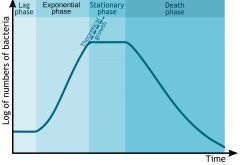![]()
![]()
![]()
Use LEFT and RIGHT arrow keys to navigate between flashcards;
Use UP and DOWN arrow keys to flip the card;
H to show hint;
A reads text to speech;
18 Cards in this Set
- Front
- Back
|
The generation time |
is the time between two successive divisions. |
|
|
Aerotolerant anaerobes |
have an anaerobic pattern of metabolism but can tolerate the presence of oxygen because they possess superoxide dismutase |
|
|
Capnophilic bacteria |
bacteria which require higher concentration of CO2 (5-10%) for growth. |
|
|
Mesophiles |
are organisms able to grow within a temperature range of 20-40*C. |
|
|
Psychrophiles |
(cold-loving) are capable of growth at refrigerator temperature (0-8*C) e.g. Flavobacterium spp. |
|
|
Thermophiles |
(heat-loving) grow best at high temperature (>60*C) e.g. Bacillus stearothermophilus |
|
|
Growth |
It is the increase in number and size of organisms. It can be seen in one of two main forms: 1- Development of colonies, which are the macroscopic products of 20-30 cell divisions of a single bacterium on solid medium. 2- Transformation of a clear fluid medium to a turbid suspension. |
|
|
Colony |
it is the macroscopic product of 20-30 cell divisions of a single bacterium. |
|
|
Bacterial reproduction |
Takes place by simple binary fission : 1- the cell grows in size, usually elongates. 2- The bacterial chromosome acts as a template for the replication of another copy. 3- Each copy becomes attached to a mesosome on the cytoplasmic membrane. 4- The protoplasm becomes divided into two equal parts by the growth of a transverse septum from the cytoplasmic membrane and cell wall. |
|
|
Classification of bacteria according to O2 requirement: |
1- Obligate (strict) aerobe 2- Obligate (strict) anaerobe 3- Facultative anaerobe 4- Micro-aerophilic 5- Aerotolerant anaerobe |
|
|
Growth Phases (bacterial growth curve) photo
|

1- Lag phase
2- Log phase (Logarithm/ Exponential) 3- Stationary phase 4- Decline phase |
|
|
The time needed for development of colonies of M. tuberculosis |
generation time= 24 hours colony= 20-30 times 1*20= 20-30 days |
|
|
Most bacteria of medical imp are Heterotrophs. |
because these bacteria require organic sources of carbon, as the cannot synthesize complex organic substances from simple inorganic sources. |
|
|
Obligate anaerobes die in the presence of oxygen. |
due to accumulation of superoxide and hydrogen peroxide because it lacks the enzymes superoxide dismutase and catalase, which detoxify these molecules. |
|
|
The net ATP yield in anaerobic respiration is less than it is with aerobic respiration |
In anaerobic respiration the final electron acceptor is an inorganic molecule such as nitrate, sulfate or CO2 which are not as good at accepting electrons as oxygen. |
|
|
The number of viable bacteria is constant during the stationary phase. |
because the loss of cells through death is balanced by formation of new cells through growth and division. |
|
|
The number of viable bacteria decreases during the decline phase. |
due to nutrient exhaustion and accumulation of toxic metabolic end products. |
|
|
The number of bacteria remains constant in the lag phase. |
because there is no growth of bacteria which only adapts to the new environment by forming enzymes and intermediates to permit growth. |

